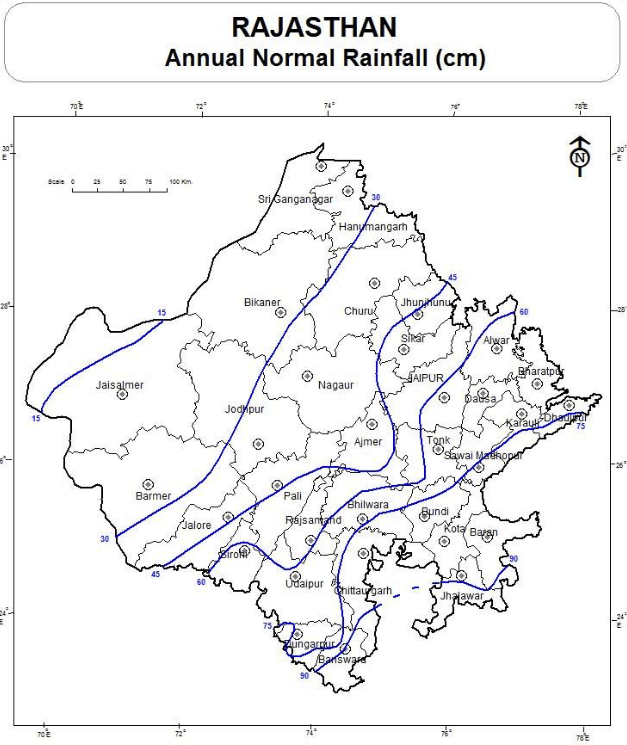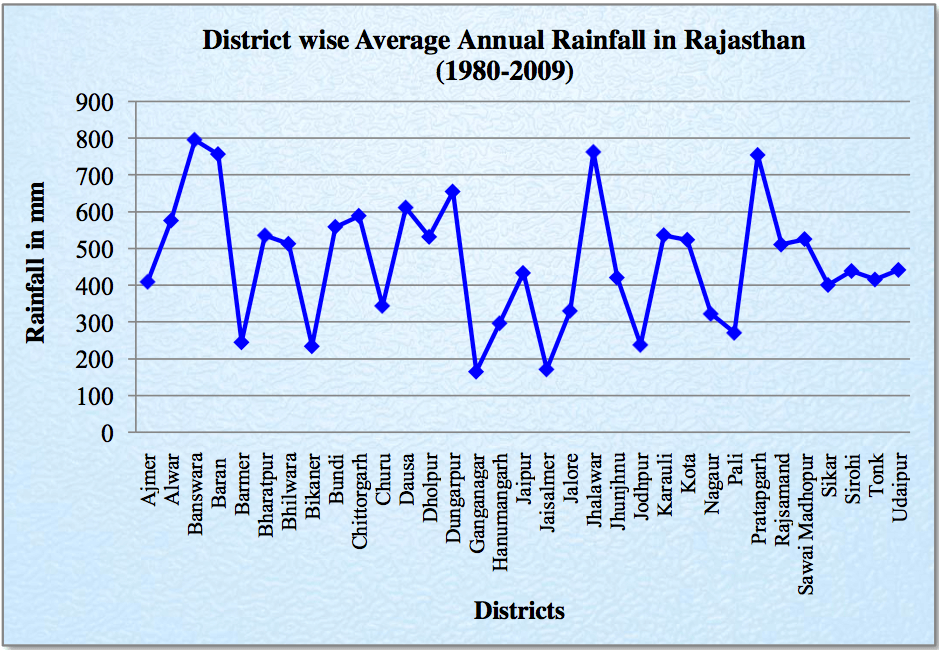The total normal annual rainfall in Rajasthan varies from 1000 cm over the South-Eastern parts to 14 cm over the extreme North-Western parts. Below is the graph for annual normal rainfall in Rajasthan:

Variation in Rainfall during the Year
- Rajasthan receives about 91% of its annual rainfall is during the South-West monsoon.
- Rajasthan receives about 2% share of rainfall during the cold weather season.
- About 3% during the summer season.
- Nearly 4% during the post-monsoon season.
of the annual total rainfall respectively.
The onset of the southwest monsoon over the eastern parts of the state is witnessed almost by the last week of June which extends over the entire state by the first week of July.
Amounting individually to about 34% of the annual rainfall each, July and August are generally the rainiest months. Around 1st September the withdrawal of the southwest monsoon begins from the northern western parts of the state and by 15th September it withdraws from the entire state. During cold weather season a small amount of rainfall i.e. 1cm and 0.7 cm in East and West Rajasthan is received.
This respectively is of great significance for agriculture and if occurs in association with western disturbances which move from west to east across the northern parts of the country.
During the south-west monsoon period extending from June to September the state receives about 90% of the total rainfall. The cold weather period (January and February) receive the Remaining portion of rainfall which occurs in association with the local convective activity.
Distribution of Rainfall in Rajasthan:
There is a wide variation in the mean annual rainfall over Rajasthan as the extreme western parts of Jaisalmer district receive rainfall less than 100mm in contrast to more than 900mm in the eastern parts of Jhalawar and Banswara. The districts of East Rajasthan receive more rainfall than those of West Rajasthan. The mean annual rainfall in the East and West Rajasthan is about 64.9 cm and 32.7 cm respectively.
The maximum rainfall in the state is received in the Southern or South- Eastern districts of the state. On the west of Aravalli hills in Pali and Jalore districts receive maximum amount of rain of 50 cm and 43 cm in West Rajasthan.
In the North or North-Western districts Jaisalmer district receives the lowest rainfall. Bikaner, Ganganagar, Jaisalmer receive annual rainfall of 26cm, 24cm and 17cm respectively. The adjoining areas of these districts constitute the driest zone of the state.

The lowest recorded annual rainfall in the past 100 years i.e. between 1900 and 2010 was 24 mm in the western Rajasthan and whereas it was never below 120 mm in the eastern Rajasthan.
Rainfall during 2020
As per information of Indian Meteorology Department, the rainfall patterns indicate that during monsoon season of 2020, the onset of monsoon was delayed by 9 days. The normal date of arrival of monsoon in the state is 15th June, but it arrived on 24th June. It covered the whole state till first week of July, 2020..
The actual rainfall in the period from 1st June to 30th September, 2020 in the state was 520.79 mm, as compared to normal rainfall of 520.98 mm, which is 0.04 per cent less than the normal rainfall.
In Rajasthan, during the entire monsoon season 2020, there have been abnormal, excess or normal rains in most of the districts, where as in Alwar, Baran, Bharatpur, Bundi, Dausa, Dholpur, Ganganagar, Kota and Tonk districts, deficit rainfall has been recorded.
